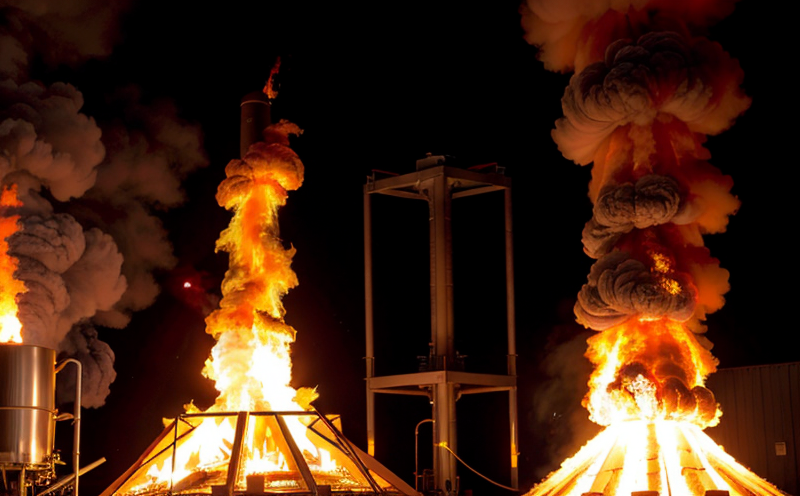DIN EN 50265 Flammability Testing of Electrical Cables
The DIN EN 50265 standard is a pivotal guideline for ensuring the safe use and installation of electrical cables in various environments. This standard addresses the flammability characteristics of electrical cables, which are crucial to prevent potential fire hazards that can arise from cable failures or malfunctions.
Flammability testing under DIN EN 50265 is designed to evaluate how a cable behaves when exposed to flames, including its propensity to ignite and the rate at which it burns. This testing method is essential for ensuring compliance with safety regulations across industries such as electrical engineering, construction, and manufacturing.
The test involves subjecting the sample cables to specified flame conditions in a controlled environment. The standard specifies different types of tests based on the cable’s intended use: indoor or outdoor applications. Indoor testing typically uses a gas burner while outdoor tests may involve other specific setups depending on expected environmental exposure.
During these tests, critical parameters like peak heat release rate (PHRR), smoke production, and carbon monoxide generation are measured to assess the cable’s flammability behavior. Compliance with DIN EN 50265 not only ensures product safety but also helps manufacturers meet regulatory requirements set by national and international standards organizations.
The importance of this testing cannot be overstated given that electrical cables form a significant part of many critical infrastructure systems, from residential buildings to industrial facilities. By adhering to DIN EN 50265 guidelines during production processes, companies can significantly reduce the risk of fires caused by improperly manufactured or installed cables.
Furthermore, implementing this standard promotes better overall safety practices within organizations responsible for designing and operating electrical systems. It also encourages innovation in developing safer materials and designs that meet stringent international standards like DIN EN 50265.
In summary, DIN EN 50265 provides a robust framework for assessing the flammability of electrical cables, ensuring they perform safely under fire conditions. This contributes to creating more secure environments where electricity is used extensively.
Scope and Methodology
The scope of DIN EN 50265 encompasses the evaluation of flammability properties for electrical cables, particularly focusing on their resistance to ignition in specified flame conditions. This standard applies to both indoor and outdoor applications depending upon where the cable is intended to be used.
For indoor installations, the test typically involves placing a sample length of cable within a chamber equipped with a gas burner capable of producing flames according to predefined specifications. The duration for which the flame contacts the cable must meet specific criteria outlined in the standard. During this time, various parameters are measured including PHRR, smoke production index (SPI), and carbon monoxide concentration.
Outdoor testing differs slightly; it might involve exposing the cables to natural elements such as sunlight or rain before subjecting them to flame exposure. These environmental factors can influence how a cable behaves during actual usage outdoors.
The methodology outlined in DIN EN 50265 ensures consistent results across different laboratories by providing detailed instructions on specimen preparation, test setup, and data recording procedures. Compliance with these methods guarantees accurate assessment of a cable’s flammability characteristics, thereby enhancing confidence in the safety performance of electrical systems.
It is important to note that while DIN EN 50265 primarily deals with flammability testing, it does not cover other aspects such as mechanical strength or electrical insulation properties. However, successful completion of this test forms one crucial step towards achieving full compliance with broader safety standards applicable to electrical cables.
In conclusion, the rigorous approach prescribed by DIN EN 50265 ensures that only those products meeting strict flammability requirements are allowed on marketplaces globally. This contributes significantly toward reducing risks associated with fire incidents linked to improperly manufactured or used electrical cables.
Industry Applications
- BUILDING CONSTRUCTION: Ensuring that all electrical components installed in residential and commercial buildings comply with safety regulations regarding flammability is paramount. DIN EN 50265 helps architects, builders, and contractors select appropriate cables for specific projects.
- INDUSTRIAL FACILITIES: In industrial settings where large quantities of electrical equipment are deployed, preventing accidental fires due to cable failures can save lives and protect valuable assets. Compliance with DIN EN 50265 ensures that the infrastructure meets necessary safety standards.
- TRANSPORT: Public transport systems rely heavily on reliable electrical cabling for power distribution, signaling, and communication networks. Adhering to DIN EN 50265 guarantees that these critical components function safely even during emergencies.
- HOSPITALS AND HEALTHCARE FACILITIES: Any interruption in the power supply can lead to severe consequences at healthcare institutions. By ensuring compliance with DIN EN 50265, facilities maintain uninterrupted access to essential services despite potential disruptions caused by fires.
In all these sectors, proper flammability testing as per DIN EN 50265 plays a vital role in safeguarding public health and property while fostering efficient operations within various industries.
Eurolab Advantages
At Eurolab, we pride ourselves on offering comprehensive services aligned with the highest international standards. When it comes to DIN EN 50265 flammability testing of electrical cables, our expertise lies in providing accurate and reliable results that meet your stringent requirements.
- Accurate Testing: Our state-of-the-art facilities equipped with advanced instrumentation ensure precise measurement of key parameters such as PHRR, SPI, and CO generation during the testing process.
- Expertise: Our team comprises highly qualified professionals who possess extensive experience in conducting flammability tests across various industries. They stay updated on latest developments within the field ensuring that our services remain relevant.
- Compliance Assurance: By adhering strictly to DIN EN 50265 guidelines, we guarantee that every test conducted meets all necessary regulatory requirements thereby facilitating easier compliance for clients.
We understand the importance of trust and reliability in testing services. Therefore, our commitment is to deliver consistent quality results backed by robust documentation supporting your decision-making process.





